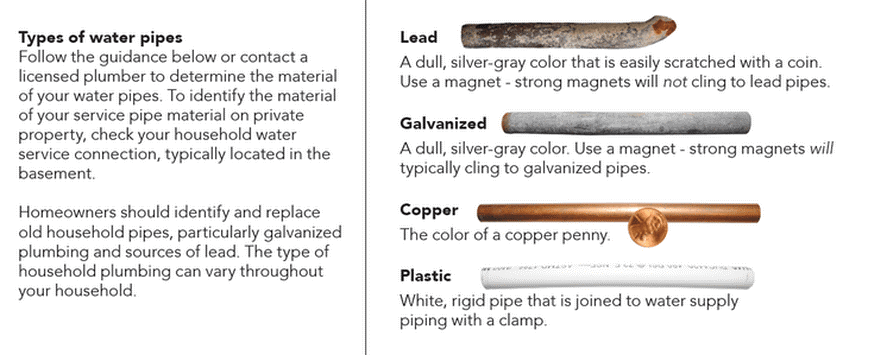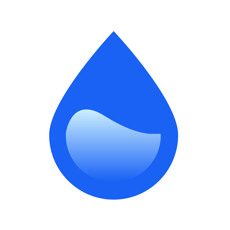Lead and Copper: Important Updates and Information
Updates
On December 16, 2021, the U.S. Environmental Protection Agency (EPA) announced changes to the Lead and Copper rule, which was originally established in 1991. The purpose of these changes is to ensure that any existing lead service line in the country is removed and replaced by the end of 2025.
Based on decades of working in the community and the inventory of data we have on installed service lines, the Hicksville Water District is confident that if there are any lead service lines remaining within the District that they are few and far between. With that said, 100 percent confidence is needed, so the District is embarking on an aggressive data collection effort to confirm the materials used for every service line in the District which we do not already have on record. The District will need the assistance of the Hicksville residents to complete this task.
Water Service Line Dashboard
To check the material of your water service line, please click on the link below. If your water service material is not indicated or labeled as unknown, please contact the Water District at 516.931.0184 or info@hicksvillewater.org for more information. You can also self inspect your water service by following the instructions below.
Homeowner Self Certification of Service Line Material
It is important to know that replacement of service lines, the underground pipes that connect a home or business to the public water distribution system, are the responsibility of the home/business owner. The Water District’s jurisdiction ends at the curb. However, we are here to help.
The below details provide all the information a resident will need to confirm the material of their service line.
Visual Scratch Testing
Lead is a dull gray color and very soft. If scraped with a key, it will turn a bright silver color. Even a very strong magnet will not stick to lead.

Reporting Results to the District
Residents that have been contacted by the District to self-certify due to the District not having records of their service line material are asked to complete and submit the below form. If you have any questions or concerns, please feel free to contact us at 516-931-0184 or email info@hicksvillewater.org.
Please note that survey results will be shared exclusively with the Hicksville Water District and H2M Architects + Engineers, and any information entered is used strictly for survey information purposes. If you have any questions, please contact the District at 516-931-0184 or info@hicksvillewater.org.
This testing is free to qualified homeowners. Please contact the Water District for additional information to see if you qualify and to obtain sampling bottles and instructions. The following video contains useful sampling instructions that are critical for obtaining accurate testing results.
Drinking Water Lead and Copper Sampling Instructions
IT IS IMPORTANT THAT YOU READ THESE INSTRUCTIONS COMPLETELY BEFORE SAMPLING. THIS WILL ALLOW US TO OBTAIN AN ACCURATE MEASUREMENT OF THE LEAD AND COPPER IN YOUR DRINKING WATER. THIS SAMPLE SHOULD REPRESENT THE WATER AND THE FAUCET WHERE YOU TYPICALLY DRINK WATER.
1. Water must remain motionless in the pipes before sampling. Therefore, DO NOT USE ANY WATER in the house for at least six hours before sampling. The most convenient times to sample may be early morning, after school, or after returning from work.
2. Select an unfiltered/untreated faucet in the KITCHEN or BATHROOM that has been commonly used for drinking in the past few weeks.
*DO NOT sample from a laundry sink, bathtub, or hose spigot as these samples do not represent water typically consumed.
*DO NOT use a faucet that has a filter attached to it unless you bypass or remove the filter.
*DO NOT use a faucet that is connected to a home water treatment device like a water softener, iron filter, or reverse osmosis.
*DO NOT remove or clean the aerator immediately before sampling.
3. Place all bottles in order next to the kitchen or bathroom sink. Open all bottles, place the caps on the counter, and be careful not to touch the inside of the bottles or caps.
4. Place the FIRST LITER sample bottle below the faucet and then turn on the COLD-WATER tap. If you have a single handle faucet, turn it fully to the COLD side. Fill the first sample bottle to the neck and be prepared to immediately start filling the next bottle once the first bottle has been filled. Repeat this process until all bottles are full. DO NOT turn off the faucet in between filling sample bottles.
5. Tightly cap the FIRST and FIFTH bottles. Pour the other bottles out in the sink. Review the sample kit label to ensure all information contained on the label is complete and correct.
6. Answer the questions on the back of the provided form and sign the form.
7. Attach the certification form provided you to the sample kit and arrange pick-up according to the instructions provided by the Water district.
Lead FAQ
What are the acceptable levels of lead in water?
The EPA has established a action level for lead in drinking water at 15 parts per billion.
What is the level of lead in water being supplied by the Hicksville Water District?
The Hicksville Water District routinely samples the public drinking water for detections of lead and we are proud to report that our water surpasses all established water quality standards. Robust water quality sampling and testing have delivered results of non-detect to 2.7 parts per billion – well below the MCL of 15 parts per billion.
Why would an elevated level of lead in drinking water be detected in my home?
Water being delivered to our residents’ homes does NOT contain elevated levels of lead. If the drinking water in your home has elevated levels of lead, it is due to the presence of a lead service line or other lead-based pipes, joints or fixtures in your home’s plumbing system. Decades ago, lead was a common material used in residential plumbing and fixtures. Older homes have a higher likelihood for the presence of lead-based materials.
Is the Water District responsible for addressing lead piping?
It is important to note that the District’s jurisdiction ends when pipes start to branch off from water mains below the street and into homes. Thus, it is the homeowner’s responsibility to address any possible lead piping from the curb into their home and any internal plumbing within their home.
Unfortunately, the District does not have funds available to help offset the costs to homeowners for lead service line replacements, however, we are working with our area’s elected officials in the hopes of creating a funding stream.
How can I test for lead in my water?
If you are concerned about the potential presence of lead in the drinking water within your home, the District recommends you reach out to a state-certified laboratory for comprehensive and accurate results.
Where can I learn more about lead in drinking water?
There are many great resources available to help residents better understand the impacts of lead in drinking water and how to address it. Here are a few resources that we find to be the most helpful:
www.epa.gov/ground-water-and-drinking-water/basic-information-about-lead-drinking-water
www.health.ny.gov/environmental/water/drinking/lead/
www.awwa.org/Resources-Tools/Resource-Topics/Contaminants-of-Concern/Lead



